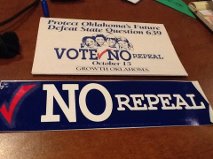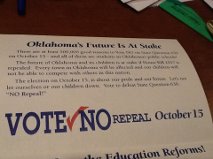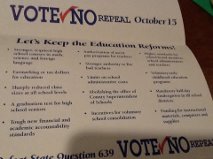Remembering HB 1017
I was in college when it passed – landmark legislation to reform and increase funding for public education. Having grown up in an education family, I heard the reasons why we should support this: smaller classes, better pay, new Kindergarten and early childhood programs. As a future teacher, it all sounded good to me – even the parts I didn’t understand at the time.
Today, on the 25th anniversary of its passage, the Democrats in the Legislature marked the occasion with a press release and a cake:
OKLAHOMA CITY (April 27, 2015) – House Democrats on Monday marked the 25th anniversary of House Bill 1017, the landmark school reform measure enacted in 1990 to substantially improve the state’s common education system.
The legislators were joined by educators for the celebration, which was replete with a custom-baked cake, in the House Lounge at the State Capitol.
“We gathered here today to commemorate the passage 25 years ago of this historic piece of legislation and to reflect on its legacy,” said House Democratic Leader Scott Inman, D-Del City.
“But we also think it’s appropriate to point out that three of its primary pillars – smaller class sizes, better pay for teachers, and increased funding for public schools – have been systematically eroded over the intervening years.”
Genesis of HB 1017
Prior to 1990, Oklahoma steered away from drastic reforms that departed from the core of public education in the state since the 1960s and ’70s: local control.
However, realizing that education reform needed to be broader in scope to ensure that all Oklahoma children would benefit, both the executive and legislative branches of the Oklahoma government began to work with various stakeholders to attempt to bring Oklahoma to the forefront of achievement.
Then-Gov. Henry Bellmon, this state’s first Republican governor, signed House Joint Resolution 1003 creating “Task Force 2000” in May 1989, sparking what has since become a constantly changing tide of reforms and budget battles over education for the last 25 years.
Later that same year, then-House Speaker Steve Lewis began to develop his own education plan, “Education: Challenge 2000.” The Legislature went into a special session dedicated to the bill and spent seven days ironing out the myriad provisions of this singular piece of legislation.
House Bill 1017 was the culmination of Task Force 2000 recommendations and Speaker Lewis’ plan, and was endorsed by several thousand school teachers who thronged to the Capitol for a rally in support of the measure. The bill was signed into law by the late Governor Bellmon on April 25, 1990.
HB 1017 is widely deemed to be the single most important piece of legislation regarding education reform in Oklahoma. Yet in the quarter-century since passage of the bill, Oklahoma has experienced a substantial increase in students, fluctuating budgets, and the dismantling of several key reforms.
Reforms Implanted in HB 1017
Among the host of reforms incorporated into HB 1017:
- Progressive increases in the minimum teacher salary schedule were scheduled.
- Maximum class sizes were established at 20 students for grades 1-6; 36 for grades 7-9; and 120 students per day for grades 7-12. Also, class sizes were incorporated into a school’s accreditation criteria.
- Statewide curriculum standards were introduced. In the future, high-school graduation would be based upon attainment of specified levels of competencies in each area of the core curriculum, rather than upon simply the time a student had spent attending school.
- Norm-referenced testing was established for grades 3, 5, 7, 9 and 11, to provide a national comparison.
- HB 1017 intended for millions of additional dollars to be pumped into this state’s public school system.
- The legislation mandated that members of local school boards and the State Board of Education had to have obtained either a high-school diploma or a GED diploma, and continuing education was required for members of local school boards.
- Half-day kindergarten attendance became compulsory in 1991-92, and school districts were encouraged to offer all-day kindergarten starting in 1993-94. In addition, school districts were permitted to offer pre-K for at-risk children, to supplement the federal Head Start program.
- The office of County Superintendent of Schools was abolished.
- Hands-on vocational programs for all students were encouraged.
These were great reforms and made an impact in Oklahoma for a generation. That almost didn’t happen, however. As soon as Republican Governor Henry Bellmon signed HB 1017, the repeal effort began, culminating with the vote on State Question 639 on October 15, 1991. It took 126,796 signatures to get the question to the ballot. In the end, the initiative was defeated by a vote of 54% to 46%.
For some reason, I’ve saved the bumper sticker and brochure all these years.
I thought I had also saved the column I wrote for the OU Daily at the time (which triggered a few angry phone calls from 639 supporters – my first experience with that). I can’t find what I wrote anywhere online, but I can find what then-Oklahoman editorial writer Patrick McGuigan wrote. I’ll spare you the details, but it’s a laundry list of reasons for the state question’s supporters to have hope.
The group trying to keep 1017 had their own reasons:
I don’t remember the graduation test that came from 1017. Do you? Honestly, don’t these reforms sound familiar? Standards…check. Financial accountability…check. Firing bad teachers…check. School consolidation…check. Some ideas just never get old. We hear the same things from reformers now, but without the funding promised in 1990.
For their part, the House Democrats enumerated the ways in which the reforms of HB 1017 have been rolled back:
Where We Are Today
- In the 1988-89 school year, Oklahoma ranked 48th in the nation and next-to-last in the region in average teacher salaries.
- The average teacher salary in Oklahoma 24 years later, in 2012-13, was 48th lowest in the nation, last in the seven-state region (Colorado, Texas, Missouri, Kansas, Arkansas, New Mexico and Oklahoma), and almost $12,000 below the national average, according to the National Education Association.
- HB 1017 provided that in 1994-95, the salary for a beginning teacher in Oklahoma would be $24,060. In comparison, the lowest salary on Oklahoma’s minimum teacher salary schedule 20 years later, in 2014-15, is $31,600. Oklahoma’s minimum salary scheduled has not increased since 2008. Oklahoma’s average annual teacher salary is just 78% of the national average.
- At least in part because of relatively low salaries, the ratio of public school teachers in Oklahoma with advanced degrees today is 24.8%. In contrast, 41% of Oklahoma’s teachers held advanced degrees in the 1989-90 school year.
- School accreditation is no longer tied to class size; today all 500+ school districts in Oklahoma are exempt from the mandate. The current average is 17.8 students for each teacher, and 11.9 teachers for each administrator – the highest ratio in 20 years. Schools may be deregulated from any mandate that does not affect the health and safety of the students without losing accreditation.
- Dan Nolan, an AP History teacher at Norman North High School, said he has “29 chairs but 36 students” in one of his classes. Nolan was a finalist for State Teacher of the Year in 2009.
- A week ago today a House Democrat was contacted by a veteran teacher in Davenport who said she is responsible for “about 130 kids a day, 4th-7th grades.”
- Testing mandates have been amended by the Legislature every year except two since passage of HB 1017 in 1990.
- Norm-referenced testing has been replaced with criterion-referenced testing for grades 5, 8 and 11; the number of tests has grown substantially; a revolving door of five different testing vendors has caused concerns among educators, parents and legislators alike; and the state continues to spend tax dollars on testing results that do not provide a method to track progress from year to year as the standards change, nor to track a student’s fundamental growth of knowledge.
- Oklahoma has spent $81.7 million on testing since 2004.
- Educational standards in Oklahoma are in flux since passage of House Bill 3399 last year, which repealed Common Core. The State Board of Education has been directing multiple committees to develop “Oklahoma standards.” Oklahoma nearly lost a federal waiver last year due to the earlier standards, to which this state reverted, because they did not meet the State Regents for Higher Education definition of “college and career ready.”
- Revenue allocated to Oklahoma public schools remains below funding levels of a few short years ago. Oklahoma’s Republican-controlled Legislature and Republican governor have cut public education funding by 23% — more than any other state in the nation.
- The $2.507 billion appropriated for public schools for Fiscal Year 2015 was $64.5 million less than the $2.572 billion appropriated five years earlier, in Fiscal Year 2010.
- The instructional budget declined in four of the five years between the 2006-07 school year and the 2011-12 school year.
- As the “1017 Fund” has grown, legislative appropriations for common education have decreased. For example, the 1017 Fund increased by $91.2 million from FY 2012 to FY 2013. In comparison, state appropriations to education during that same period declined by $93.3 million.
- Local and county funding for public schools has increased four times faster than state funding; consequently, districts that have lower property valuations are able to generate less funding per student.
- Public K-12 schools in Oklahoma receive 38.4% of their funding from local revenues (33rd highest in the U.S.), 48.9% from state appropriations (23rd highest in the country), and 12.7% from the federal government (11th highest in the nation).
- In the fall of 1990, enrollment in Oklahoma public schools numbered a little over 579,000 students. Student enrollment in 2015 is almost 684,000, an increase of nearly 105,700, or 18%, in 25 years.
- Yet Oklahoma has the third-lowest average per-pupil funding level in the nation, leading only Nevada and Utah.
- Oklahoma schools are no longer required to have media and library assistants.
- The Legislature voted in 2010 to allow school districts to divert their annual textbook allocation and library media program funds to general school operations for the next two years. That exemption has now been authorized three consecutive times, through school years 2015 and 2016. As a result, some schools are using textbooks that are up to 14 years old and in tatters, held together with tape.
- “My school district has not purchased textbooks in 10 years, and my library has not had funding in almost as long,” a Skiatook teacher wrote to a House Democrat on April 20.
- Full-day kindergarten and a marked increase in pre-K participation led Oklahoma to be recognized as #1 in the nation for early childhood education. However, the Legislature voted to repeal that mandate in 2013.
- HB 1017 directed schools to provide technology education. Today, roughly 60% of this state’s rural schools still do not have funds needed for technological upgrades.
- The Information Technology and Innovation Foundation ranked Oklahoma 48th among the states last year in meeting the needs of the “new economy.” The ITIF index employs 25 indicators in five categories (knowledge jobs, economic dynamism, the digital economy, innovation capacity, and globalization) to assess each state’s fundamental capacity to transform its economy and incubate innovation.
- “We call today for a renewal of the principles that made House Bill 1017 such a groundbreaking measure when it was adopted 25 years ago,” Inman concluded. “This is a bittersweet anniversary, looking back on what might have been.”
It took long enough, but I guess they have finally passed SQ 639. I think I’ll pass on the cake.





Very interesting read. I hope it doesn’t take another walkout to get what students and teachers need in OK.
LikeLiked by 1 person
Having those make decisions concerning education that have never been a part of the education system is like me deciding what treatment should a sick patient have to survive a terrible disease.A walk thru visit to a school in ones district is just a show.They have not a clue what is really needed.As long as our legislators get their raise they are happy..Frankly I am sick of all of our elected officials.This just gets to deep and the education always looses.
LikeLike
I was a substitute teacher in almost every grade off and on throughout the 90s. I remember being happy that 1017 passed. It was the most forward-thinking, positive move for public schools I had known of. I also recall the fight waged against 639 and being pleased when it was defeated.
Then as time went by I noticed class sizes growing again. Later I began realizing that when I subbed in the elementary grades after January, there was sure a lot of class time devoted to preparation for achievement tests.
I began to wonder what had happened to 1017. Teachers told me they could get by with a teachers aide when class size got too big.
In 2000 I went to work at the local newspaper and began to follow education news more closely, not liking much of what I read.
I read the press release issued yesterday about the anniversary of 1017 with interest. I must agree, I’ll pass on the cake too.
LikeLike